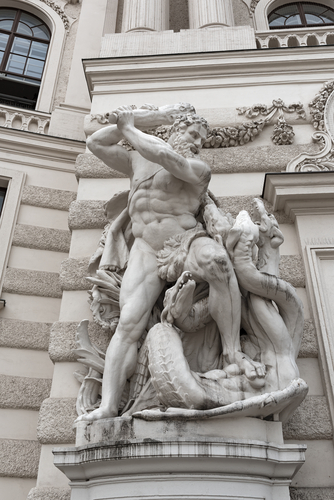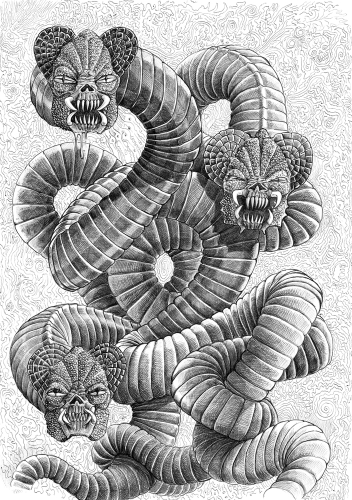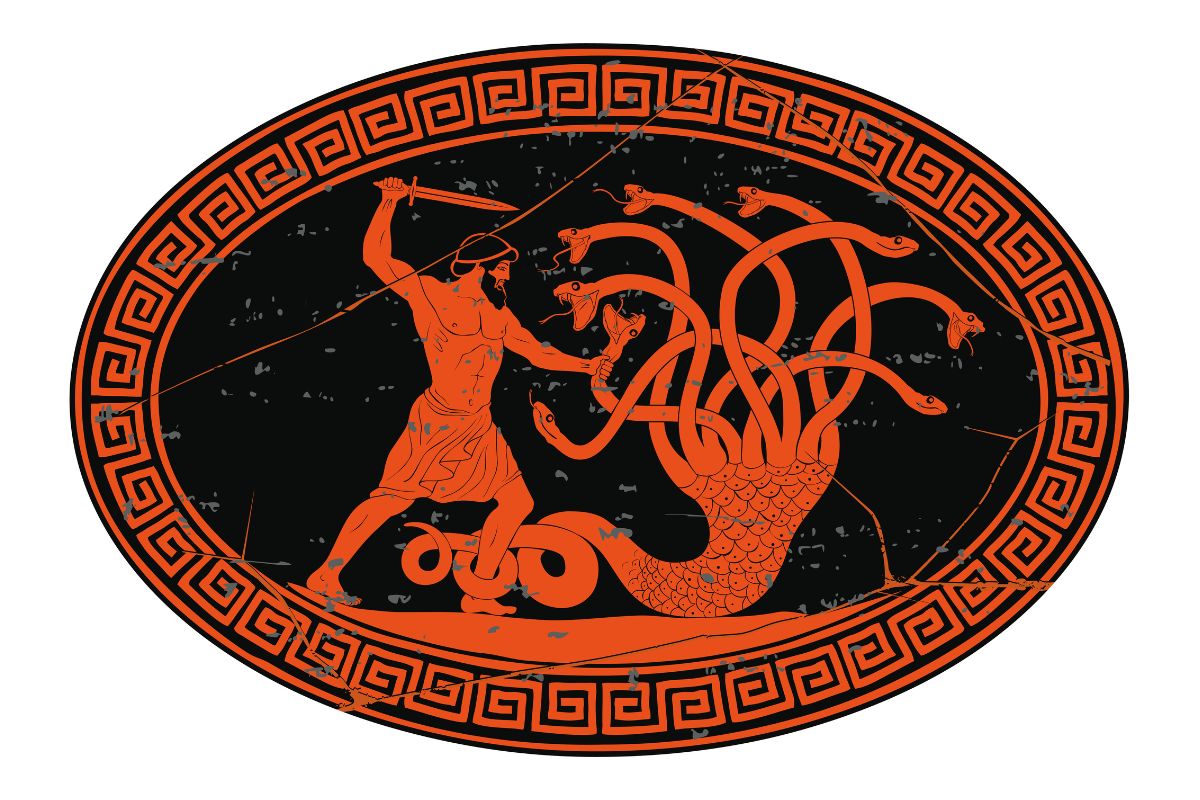In Greek mythology, the Hydra was a monstrous serpent-like creature with multiple heads and deadly abilities. Born from the union of Typhon and Echidna, the Hydra resided in the swamps of Lerna.
Its most famous encounter was with the hero Heracles, who faced it as one of his Twelve Labors. The Hydra possessed the ability to regenerate its heads, making it a formidable opponent.
With the help of his nephew Iolaus, Heracles managed to overcome the creature by cauterizing the stumps to prevent regrowth. The Hydra’s defeat symbolized Heracles’ bravery and resilience in the face of seemingly insurmountable challenges.
The myth of the Hydra has been interpreted in various ways, reflecting themes of personal growth, the persistence of evil, and the triumph of heroism.
Hydra Facts
1. The Hydra was a monstrous serpent-like creature
In Greek mythology, the Hydra was described as a fearsome creature with the body of a serpent. It was often depicted as having multiple heads and a serpentine tail.
The Hydra was known for its immense size and strength, as well as its deadly nature.

2. It had nine heads and poisonous breath and blood
The Hydra was typically depicted with nine heads, although some variations of the myth mention a different number of heads, ranging from seven to fifty.
These heads were said to be extremely dangerous, with the ability to spew venomous breath and possess toxic blood.
3. The Hydra was born from Typhon and Echidna
According to Greek mythology, the Hydra was one of the offspring of Typhon, a monstrous creature associated with chaos and destruction, and Echidna, a half-woman and half-serpent creature known as the “Mother of All Monsters.”
Also Read: Facts About the Phoenix
The Hydra was born in the swamps of Lerna, a region in the Peloponnese, which became its dwelling place. The parentage of the Hydra emphasized its monstrous lineage and contributed to its formidable nature.
4. The Hydra’s lair in the marshes of Lerna was a treacherous and foul-smelling place.
Lerna was a region located in the Peloponnese, and the marshes were known for their swampy and murky terrain. The lair of the Hydra was said to be a dark and foreboding cavern hidden within the marshlands.
The marshes of Lerna were notorious for their many hazards, including dangerous creatures, poisonous plants, and hidden traps. The treacherous landscape posed a significant challenge for Heracles as he ventured into the lair to confront the Hydra.
The mucky terrain made it difficult to move swiftly and added an extra layer of danger to the already perilous task of facing the multi-headed serpent.
Additionally, the foul smell in the lair was attributed to the poisonous breath and blood of the Hydra. The creature’s venomous presence filled the air with a noxious odor, further heightening the tension and sense of danger surrounding the battle.

5. Heracles (Hercules) was tasked with killing the Hydra as one of his Twelve Labors
Heracles, also known as Hercules in Roman mythology, was assigned the arduous task of killing the Hydra as one of his Twelve Labors. These Twelve Labors were a series of extraordinary tasks imposed upon Heracles as punishment for an act of madness in which he killed his wife and children under the influence of Hera, the queen of the gods.
Among the Twelve Labors, the Hydra’s extermination was considered one of the most challenging and dangerous. Hera, who held a grudge against Heracles, orchestrated this particular task in an attempt to harm him.
By sending the Hydra, a monstrous and nearly invincible creature, Hera hoped to thwart Heracles’ efforts and put an end to his heroic accomplishments.
6. The Hydra could regenerate its heads when they were cut off
One of the most notable characteristics of the Hydra was its remarkable ability to regenerate. Whenever one of its heads was severed, two new heads would grow in its place. This made the Hydra an incredibly challenging opponent, as it could quickly multiply its heads, making it difficult for its adversaries to defeat it.
7. Heracles had help from his nephew Iolaus during the battle with the Hydra
During his encounter with the Hydra, Heracles enlisted the assistance of his nephew Iolaus. As Heracles cut off the Hydra’s heads, Iolaus would immediately cauterize the stumps to prevent new heads from sprouting. This strategy was crucial in their efforts to overcome the Hydra’s regenerative powers and ultimately defeat the creature.
8. Heracles used the Hydra’s poison to coat his arrows
As Heracles fought against the Hydra, he discovered that its venomous blood possessed potent and deadly properties. Heracles realized that by dipping his arrows in the Hydra’s poisonous blood, he could create lethal weapons. This tactic proved valuable in subsequent battles and became one of Heracles’ signature strategies, showcasing his resourcefulness and adaptability in combat.
9. One of the Hydra’s heads was immortal, which Heracles buried under a rock
During his battle with the Hydra, Heracles discovered that one of its heads was immortal. No matter how many times he cut it off, it would continue to grow back. To neutralize this immortal head, Heracles devised a clever plan. After severing the immortal head, he buried it deep beneath a massive rock. By doing so, he effectively eliminated the threat posed by that particular head, preventing it from causing further harm.
10. The Hydra’s defeat symbolized Heracles’ heroism and overcoming challenges
The battle between Heracles and the Hydra was a significant episode in his heroic journey. Heracles’ victory over the seemingly invincible Hydra symbolized his exceptional strength, courage, and resourcefulness. It showcased his ability to overcome formidable obstacles and triumph over the forces of evil, further solidifying his reputation as a legendary hero in Greek mythology.
